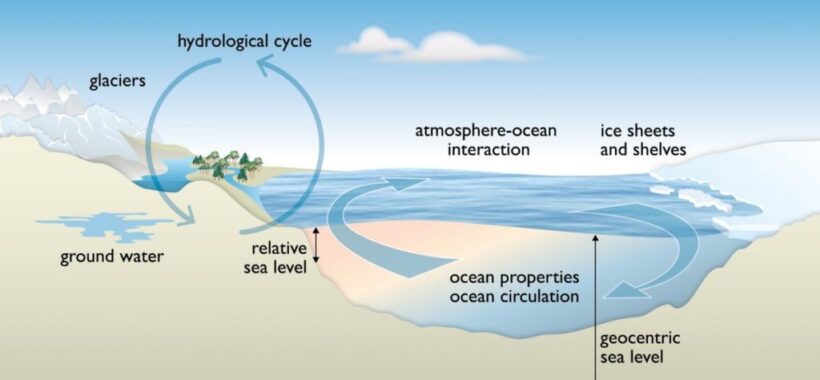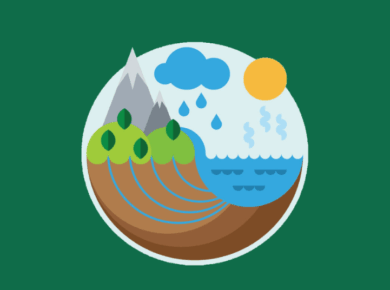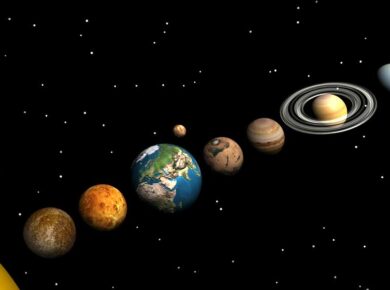Hydrosphere – Movement of Oceanic Water
Movement of Oceanic Water > Never Static
- Vertical Movement > Tides
- Horizontal Movement > Ocean waves & Ocean currents
Tides
- Periodic rise & fall in level of water in the oceans mainly caused by gravitational pull of sun & moon
- Due to the large size of sun it should attract more but because of its greater distance from the earth (1.5 x 10^8 km), it is unable to exert much influential gravitational force
- Whereas moon is much smaller than the sun but attracts more due to its lesser distance from the earth (4.07 x 10^5 km)
- Hence, it produces a force approx. 2.17 times stronger than the sun
- Centrifugal force caused by earth’s rotation is another major cause of tides formation
- Together the gravitational pull & centrifugal forces are responsible for creating two major tidal bulges on earth.
- On side facing the moon, tidal bulge occurs due to gravitational pull of the moon whereas on opposite side, tidal bulge occurs due to centrifugal force of rotation of the earth.
 Spring Tides
Spring Tides
- On full moon & new moon, moon & sun are almost in line with the earth
- Hence exerts combine pull on the earth
- On these 2 days tides are highest & called Spring tides
Neap Tides
- When moon is in the 1st quarter or last quarter, sun & moon makes right angle to each other, with earth as center
- Hence attraction of sun & moon balances each other, which results in low amplitude tides known as Neap tides
Ocean Waves
- Oscillatory movements in water manifested by alternate rise & fall of sea surface
- Formed mainly by friction & pressure of wind on sea surface
- Water in waves does not move, only wave train move
- Means if we throw a cork in water, it will move up & down (to & fro) with approaching wave but will not travel unless blown away by the wind
Ocean Currents
- Ocean currents are the large masses of surface water that circulates in regular pattern around the oceans
- Only water in current moves forward while water on its sides & below remains almost stationary
- Those that flow from equatorial region polewards have a higher surface temperature & are warm currents
- Those that flow from Polar Regions equator ward have a lower surface temperature & are cold currents
Major factors > Prevailing winds, salinity differences of water, Density, Temp. difference, Evaporation, Rotation & revolution of earth, Shape of coasts, coriolis force, gravitational force
- Prevailing winds are the major factors as they blow consistently in one direction & drag the surface water due to force of friction
- There is much difference in the temp. of ocean water at the equator & at the poles
- As warm water is lighter & rises, and cold water is denser & sinks; warm equatorial water move slowly along the surface polewards, while the heavier cold water of polar regions creeps slowly along the bottom of the sea equatorwards
- Waters of high salinity is denser than the waters of low salinity, hence the waters of low salinity flow on the surface of water of high salinity, while water of high salinity flow at the bottom towards the water of low salinity
Circulation of Atlantic Ocean (1/6th of the earth area)
- The steady trade winds constantly drift two streams of water from east to west as North equatorial current & South equatorial current
- Between the west flowing North & South Equatorial currents is the east flowing Equatorial counter current
North Atlantic Ocean Current Movement
- In the North Atlantic Ocean, the Cayenne current is joined & reinforced by North equatorial current
- Heads north-westward as a large mass of equatorial water into the Caribbean Sea
- Part of the current enters the Gulf of Mexico & emerges from the Florida straight between Florida & Cuba as Florida current
- The rest of the equatorial water flows northwards, east of Antilles to join the Gulf Stream off the SE USA
- Gulf Stream hugs the coast of America as far as Cape Hartteras, where it get deflected eastwards under the combined effect of westerlies & rotation of the earth; and reaches Europe as North Atlantic drift
- From the North Atlantic, it fans out in three directions viz. eastward to Britain, northward to Arctic & southward along the Iberian coast as the cool Canaries current
- The canaries current flowing southward eventually merges with North equatorial current, completing the clockwise circuit in the North Atlantic ocean
- Within this ring of currents, an area in the middle of Atlantic has no perceptible current
- A large amount of floating seaweed gathers in here & the area is called Sargasso Sea
- Apart from the clockwise circulation of currents, there are also cold currents that enter the North Atlantic from the Arctic regions, which are blown south by outflowing polar winds.
- The Irminger current or East Greenland current flows between Iceland & Greenland & cools the North Atlantic drift at the point of convergence
- The cold Labrador current drifts south-eastwards between west Greenland & Baffin island to meet the warm Gulf stream off Newfoundland
South Atlantic Ocean Current Movement
- At the shoulder of NE Brazil, the protruding land mass splits the South equatorial current into
- Cayenne current which flows along the Guiana coast
- Brazilian current which flows southwards along the coast of Brazil
- The South Atlantic Ocean follows the same pattern, but the major differences are the circuit is anti-clockwise here & collection of seaweed in mid-south Atlantic is not so distinctive
- Where the South equatorial current is split (at Cape Sao Roque), one branch turns south as the warm Brazilian current
- At about 40*S, the influence of westerlies & rotation of the earth, propels the current eastward to merge with the cold South Atlantic current
- On reaching the west coast of Africa, the current is diverted northward as the cold Benguela current
- Driven by the regular SE trade winds, the Benguela current surges equatorwards to join South equatorial current
- This completes the circulation of the currents in South Atlantic
Circulation of Pacific Ocean
-
- Deepest + Largest + Triangular in shape + 1/3rd of Earth’s area
- The NE trade winds blow the North equatorial current off the coast of the Philippines & Formosa into the East China Sea as the Kuroshio or Japan current.
- It moves poleward as North Pacific drift, keeping the ports of Alaskan coast ice free in winters.
- The cold Bering current or Alaskan current creeps southwards from the narrow Bering strait & is joined by Okhotsk current, to meet the warm Japan current as cold Oyashio current.
- The cold water eventually sinks below the warm water of North Pacific drift & part of Oyashio moves eastward as the cold Californian current along the coast of western USA, which finally coalesces with the North Equatorial current to complete the clockwise circulation.
- The South equatorial current, driven by the SE trade winds, flows southward along the coast of Queensland as the East Australian current.
- The current turns eastward towards New Zealand under the full effect of westerlies in the Tasman Sea & merges with south pacific current.
- Obstructed by the tip of southern Chile, the current turns northward along the western coast of South America as the cold Humboldt Current or Peruvian current.
- The Peruvian current eventually links up with the South Equatorial current & completes the cycle of currents in South Pacific.
Indian Ocean Circulation
- The equatorial current, turning southward past Madagascar as the Agulhas or Mozambique current merges with the South Pacific current
- Flowing eastward, it turns equatorward as cold West Australian current
- In north Indian Ocean, there is complete reversion of direction of currents between summers & winters, due to change of monsoon winds
- In summers, under the effect of SW monsoon, it flows clockwise, & in winters under the effect of NE monsoon, it flows anti-clockwise.
- Heating by solar rays’ causes expansion of water that is why near the equator ocean water is 8 cm higher in level compared to mid latitudes
For more updates, explore the Geography . Feel free to share your thoughts and comments.
If you’re passionate about building a successful blogging website, check out this helpful guide at Coding Tag – How to Start a Successful Blog. It offers practical steps and expert tips to kickstart your blogging journey!












2 comments
thankyou very much to share the knowledge.
sir ,no need anyother source precis and very useful